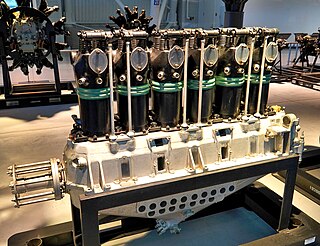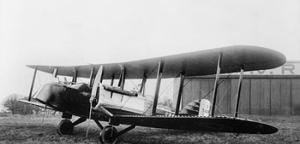
The Benz Bz.IV was a German six-cylinder, water-cooled, inline engine developed for aircraft use. Deliveries began in 1916 and some 6,400 were produced.

The Airco DH.16 was a British four-seat commercial biplane of the 1910s designed by Geoffrey de Havilland, the chief designer at Airco.

The BAT F.K.23 Bantam was a British single-seat fighter biplane produced by British Aerial Transport Company Limited of London during World War I.

The BAT F.K.26 was a British single-engined four-passenger biplane transport aircraft produced by British Aerial Transport Company Limited of London at the end of World War I.

The BAT F.K.28 Crow was a British single-seat ultralight aircraft produced by British Aerial Transport Company Limited of London. It was intended to be the "aerial equivalent of the motor cycle".

The Koolhoven F.K.51 was a 1930s Dutch two-seat basic training biplane built by the Koolhoven Company.

The Kennedy Giant was a British biplane heavy bomber designed by Kennedy Aeroplanes Ltd. during the First World War. The design was an imitation of works by Igor Sikorsky, with whom the owner of Kennedy Aeroplanes Ltd., C. J. H. Mackenzie-Kennedy, had ostensibly worked prior to setting up the company. The aeroplane was a notorious failure; its size meant that construction had to take place in an open field as none of the hangars near Hayes, Middlesex, where the prototype was assembled, were large enough to house it. For its weight, the aircraft's four engines were inadequate, and the resulting under-powered aircraft could only fly in a straight line once airborne.

The Fiat R.2 was a reconnaissance aircraft produced in Italy shortly after World War I, and the first aircraft to be marketed under the Fiat brand,. It was a conventional two-bay biplane with equal-span, unstaggered wings and fixed tailskid undercarriage. The pilot and observer sat in tandem open cockpits. The design was a derivative of the SIA 7 and SIA 9 flown during the war, but was considerably revised by Rosatelli to correct ongoing problems with those types. A total of 129 were produced for the Air Corps of the Regio Esercito.

The Avro 533 Manchester was a First World War-era twin-engine biplane photo-reconnaissance and bomber aircraft designed and manufactured by Avro.
The Grahame-White Ganymede was a prototype British heavy night bomber intended to serve with the Royal Air Force in the First World War. A large, three-engined, twin-boom biplane, the sole prototype Ganymede did not fly until after the war had ended, and although an attempt was made to convert the aircraft to an airliner, it was unsuccessful.
The Boulton & Paul P.7 Bourges was a prototype British twin-engined biplane day bomber built by Boulton & Paul to replace the Airco DH.10 Amiens. Despite demonstrating excellent performance and manoeuvrability, only three prototypes were built, post World War I cost cutting leading to the DH.10 not being replaced.
The Westland Wagtail was a prototype British fighter aircraft of the First World War. A single-engined tractor biplane, the Wagtail was a failure owing to the unreliability of its engine, only five being built.
The Sopwith Snapper was a prototype British fighter aircraft of the First World War. A single-engined biplane designed by the Sopwith Aviation Company to replace the Sopwith Snipe fighter, it first flew after the end of the war, but did not enter service owing to the failure of its engine, only three aircraft being built.

The BAT F.K.25 Basilisk was a prototype British fighter aircraft of the First World War. A single engined biplane intended to meet a requirement to replace the Sopwith Snipe, the Basilisk was unsuccessful, only three being built.

The Sopwith Bat Boats were British flying boats designed and built from 1912 to 1914. A single-engined pusher biplane, the Bat Boat was the first successful flying boat and amphibious aircraft built in the United Kingdom, with examples used by the Royal Navy and by Greece and Germany.
The Clerget 11Eb was an 11-cylinder rotary aircraft engine of the World War I era designed by Pierre Clerget. Powering Sopwith types it was nominally rated at 200 horsepower (150 kW).
The Clerget 7Z was a seven-cylinder rotary aircraft engine of the World War I era designed by Pierre Clerget. First appearing in 1911 it was nominally rated at 80 horsepower (60 kW). 347 examples were jointly built in Britain by Gordon Watney & Co Ltd of Weybridge and Gwynnes Limited of Hammersmith.

The Paalson Type 1, (Pålson), was a Swedish single-seat sport aircraft built around 1920. It was of conventional single-seat biplane layout but had some unusual features such as girder type interplane struts, a novel main undercarriage axle mounting and a mechanism allowing adjustment of the angle of incidence of the upper wing.

The BAT F.K.27 was a two-seater sporting biplane designed by Frederick Koolhoven and built by the British Aerial Transport Company Limited (BAT) in 1918.
The Goupy Type A was an staggered biplane designed by Ambroise Goupy in the early 1910s.













